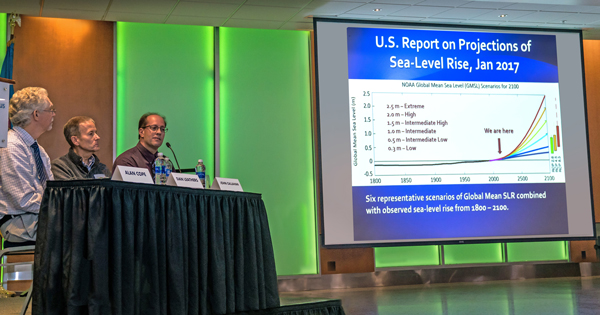


Delaware Sea Grant co-sponsors resiliency summit
Photo by Michael Graw December 01, 2017
22 local Delaware communities attend inaugural Resilient and Sustainable Communities Summit
More than 250 stakeholders from Delaware agencies, academic institutions, non-profits and, critically, 22 local Delaware communities turned out Nov. 27 for the inaugural Delaware Resilient and Sustainable Communities Summit.
The event was sponsored by Delaware Sea Grant (DESG), the University of Delaware, the Department of Natural Resources and Environmental Control (DNREC) and the Department of Transportation to highlight changing climate and weather conditions with a focus on improving community preparedness and response.
Delaware’s low-lying elevation makes the state especially vulnerable to flooding from storms and sea level rise. The Summit encouraged attendees to focus on improving community preparedness and response to extreme weather events and sea level rise. It also was the opening of what is hoped to be an ongoing dialogue where groups can engage and learn from one another’s experiences.
“Significant partnerships already exist between agencies, academia, nonprofits and local communities that are working to make Delaware more resilient,” said Jennifer Merrill, DESG research manager. “However, this summit demonstrated that there is a high need for more information, resources and networking opportunities to assist communities in preparing for and adapting to changing weather and flooding events.”
The summit comes on the heels of an above average 2017 hurricane season that included 17 named storms and 6 named hurricanes, including three category 4 hurricanes in the United States.
DNREC Secretary Shawn Garvin welcomed attendees, saying, “Resiliency is planning and preparing today for tomorrow’s hazards like storms and sea level rise so that communities can thrive and bounce back more readily.”
Panel discussions throughout the day focused on a variety of issues including storms, climatology and changing conditions in Delaware; how to improve resiliency at the community level; and a series of lessons learned, best practices and success stories from the field. Each session concluded with a robust Q&A session where audience members directly engaged with the panelists.
While hurricane season officially ended Nov. 30, storms are an important factor in major coastal flooding events, with March and October usually being standout months for coastal storms in Delaware. Climate scientist John Callahan, with Delaware Geological Survey, shared the latest 2017 sea level rise planning scenarios, which were released Monday, Nov. 27, by DGS and DNREC in conjunction with the summit. The new planning scenarios can be used by state and local emergency planners as they consider future projects.
Kathleen Lock, councilwoman for the Town of Slaughter, said towns like Slaughter Beach are the “first line of defense” against sea level rise, further underscoring the need for Slaughter and other towns to be prepared.
“Public safety in the event of a flood event, that’s a major concern,” Lock said, adding that the town is currently updating its emergency operations plan.
Lessons from Hurricane Sandy
Keynote speaker Nancy Balcom, associate director of Connecticut Sea Grant, shared information about a two-year social science study to understand how people reacted to storm warnings and made decisions to stay or go during Hurricane Sandy. The effort, supported by the Connecticut, New York and New Jersey Sea Grant programs, focused on how people obtained storm warning reports, what factors influenced decision making and how storm warnings could be more effective.
The study revealed five general classes of attitudes about hurricanes, ranging from those who were “first out” or eager to leave if a hurricane was in the forecast to “diehards” who were confident in their ability to ride out a storm. In between were those constrained by barriers such as pets, medical, financial or transportation issues; those who were optimistic their area would not be affected and others who were reluctant to go unless ordered to leave.
In making decisions, people affected by Hurricane Sandy used a variety of platforms to obtain information (television, Internet, social media), but local or state officials (like local police and fire department representatives) were considered the most trusted sources of information.
According to Balcom, one important takeaway from the study was that people make decision based on previous experience.
“People can only imagine what they’ve personally experienced,” Balcom said, making communication before, during and after an event critical.
The event culminated with an open discussion led by Philip Barnes from UD’s Institute for Public Administration, on how attendees can determine next steps to increasing resiliency in their own communities.
Other UD participants at the event included Tina Callahan, associate director of the Delaware Environmental Monitoring and Analysis Center, and Dan Leathers, Delaware State Climatologist and professor in the Department of Geography, which is based in the College of Earth, Ocean, and Environment.
Contact Us
Have a UDaily story idea?
Contact us at ocm@udel.edu
Members of the press
Contact us at 302-831-NEWS or visit the Media Relations website

